
Merbok is a mukim (sub-district) in the Kuala Muda District of Kedah, Malaysia. It is known for the historical Bujang Valley. The area also hosts the Kedah Campus of Universiti Teknologi MARA (UiTM Merbok/Sungai Petani).

Merbok is a mukim (sub-district) in the Kuala Muda District of Kedah, Malaysia. It is known for the historical Bujang Valley. The area also hosts the Kedah Campus of Universiti Teknologi MARA (UiTM Merbok/Sungai Petani).
The town derived its name from an archaic Langkasuka-Malay language, which means "the declaratory place". Based on the ancient Hikayat Merong Mahawangsa, the declaration of Islam being the state religion of the Kedah Kingdom was done in Merbok estuary port, which situated close to the kingdom's capital during the area, Bukit Meriam (Cannon Hill). This is in contrast from the popular belief that the name owed its origin from the local burung merbok (zebra dove).
5°43′N100°25′E / 5.717°N 100.417°E

Kedah, also known by its honorific Darul Aman and historically as Queda, is a state of Malaysia, located in the northwestern part of Peninsular Malaysia. The state covers a total area of over 9,000 km2, and consists of a mainland portion and the Langkawi islands. The mainland has relatively flat terrain, which is used to grow rice, while Langkawi is composed of mostly of uninhabited islands.
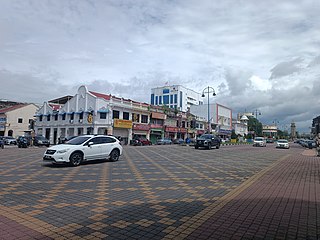
Sungai Petani is a town in Kuala Muda District, Kedah, Malaysia. Sungai Petani is Kedah's largest city and is located about 55 km south of Alor Setar, the capital of Kedah, and 33 km northeast of George Town, the capital city of the neighbouring state of Penang.

The Bujang Valley is a sprawling historical complex and has an area of approximately 224 square kilometres (86 sq mi) situated near Merbok, Kedah, between Gunung Jerai in the north and Muda River in the south. It is the richest archaeological area in Malaysia.

Beruas is a small town and mukim in Manjung District, Perak, Malaysia.
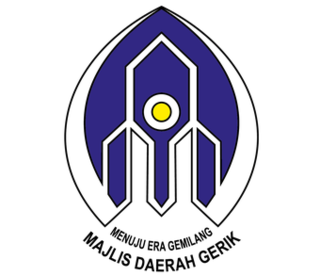
Gerik is a mukim and the district capital of Hulu Perak District, Perak, Malaysia. The town is also known as Rest Town due to its strategic location next to East-West Highway Federal Route 4, the main route linking Kedah, Penang and Kelantan.
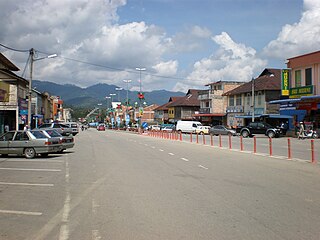
Pengkalan Hulu, formerly known as Kroh or Keroh, is a town and a mukim in Hulu Perak District, Perak, Malaysia, bordering Thailand and Kedah. The nearest town on the Thailand side is Betong in Yala province.

The Kedah Sultanate is a Muslim dynasty located in the Malay Peninsula. It was originally an independent state, but became a British protectorate in 1909. Its monarchy was abolished after it was added to the Malayan Union but was restored and added to the Malayan Union's successor, the Federation of Malaya.

Gurun is a mukim in Kuala Muda District, Kedah, Malaysia. "Gurun" in English means desert, however the town does not resemble in the slightest the meaning of its English translation. Rather, it derived its name from the word "gerun", which means terrify or "kurun" meaning elephant in the Siamese dialect. These words are associated with an incident during the reign of King Ekataat’s grandsons, Sultan Jaafar Mad Azam Syah, Sultan of the Islamic State of Ayutthia, who was killed in 1876 by the invading Thai armies when they crushed his body using an elephant. This incident took place behind the current Gurun Police Station.

The Bandar Baharu District is a town, district and state assembly constituency at the southernmost end of Kedah, Malaysia. Bandar Baharu is located along the Kedah-Penang–Perak border tripoint, 37 km (23 mi) southeast of George Town, Penang's capital city.
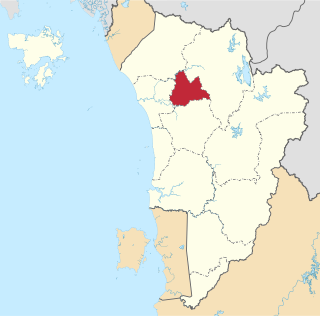
The Pokok Sena District is a district and parliamentary constituency in Kedah, Malaysia. It is the 12th district of Kedah which was formerly a subdistrict of Kota Setar, about 20 km east of Alor Setar. The declaration of the 24,000ha district with a population of 50,000 was made by the Sultan of Kedah, Tuanku Abdul Halim Mu'adzam Shah in conjunction with his 81st birthday celebrations in January 2009. The district is divided into 6 sub-districts: Gajah Mati, Jabi, Tualang, Lesong, Bukit Lada, Derang and consists of 122 villages and 21 residential areas. The Pokok Sena district lies within the boundaries of the Alor Setar City Council local government area authority.
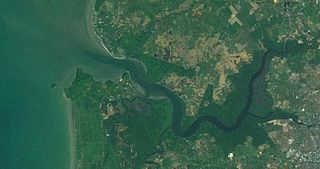
The Merbok River is a river in Kedah, Malaysia. Its sources are at Mount Jerai and Sungkap Forest. After the confluence of Bongkok and Lalang River it carry its name. Other tributaries are the Petani and Bujang River. The river mouth is around 2.5 km wide.

The Kuala Muda District is a district in Kedah, Malaysia. Sungai Petani is the administrative center of the district. Kuala Muda district is in close proximity to the border of Kedah and Penang. Apart from Sungai Petani, other major towns in the district include Tikam Batu, Padang Tembusu, Sungai Lalang, Bedong, Bukit Selambau, Sidam, Gurun, Semeling, Merbok, Kota Kuala Muda and Tanjung Dawai. The Mount Jerai is shared with the neighbouring district of Yan while the Muda River is shares the bordering state of Penang. The iconic Jambatan Merdeka connect both Tikam Batu with Bumbung Lima in Penang. Kuala Muda is the second largest and most populous district in Kedah, and it is also the site of some of the earliest civilization site in the country.

Archeological digs suggest a settlement existed on the northern bank of the Merbok River by the 1st millennium CE. The Merbok settlement, Sungai Batu was built near the river's estuary. The early history of Kedah can be traced from various sources, from the prehistoric period, most famously the archaeological site of Bujang Valley, the early maritime trade of India, Persia, and the Arabs to the written works of early Chinese pilgrims and early Chinese records, and later to the partly-historical Hikayat Merong Mahawangsa and the Al-Tarikh Salasilah Negeri Kedah.

Sungai Lalang is a small town in Kuala Muda District, Kedah, Malaysia. It is located 5 kilometer north from Sungai Petani. Sg. Lalang River situated in this town flows into the Merbok River.

Kedahan Malays or commonly known as Orang Utara ('Northerners'), are a sub-group of Malays native to northern Malay Peninsula in areas of both current and historical area of Kedah. They are among the oldest ethnic groups in the Malay peninsula with a history dating back 2,800 years as proven by the discovery of sites in Bujang Valley and historical documents from India, China and Arabia. Kedahan Malays are one of the largest Malay sub-groups in Malaysia, comprising at least 15% of the total Malaysian Malay population including those with Kedahan ancestry.
Kroh or Keruh, now known as Pengkalan Hulu, is a town in Hulu Perak District, Perak, Malaysia bordering Thailand and also the state of Kedah. The nearest town on the Thailand side is Betong in Yala province.
Sungai Petani Municipal Council is the local government which administers Sungai Petani and the whole Kuala Muda District, Kedah, Malaysia. It is the most populous local government in Kedah.

Durian Burung is a small border town in Mukim Batang Tunggang Kiri, Padang Terap District, Kedah, Malaysia. Across the border is Ban Prakop of Songkhla, Thailand.

Setul, officially the Kingdom of Setul Mambang Segara was a Malay kingdom founded in the northern coast of the Malay Peninsula. The state was established in 1808 in the wake of the partition between the rulers of the royal house of Kedah. The partition witnessed the territory being seceded to the cadet branch of the royal family. The sovereignty of the kingdom effectively ended in 1916, following the dissolution by the Siamese government. Its borders were largely inherited to its successive province, the present-day Satun, Thailand.

Kubang Pasu, officially known as the Kingdom of Kubang Pasu Darul Qiyam was a former Malay Kingdom located in the northern Malay Peninsula. The state was established in 1839 as a gift to Tunku Anum, a member of Kedahan nobility, for his efforts in ending the conflict between Kedah and Siam in the aftermath of the Siamese invasion in 1821. The kingdom witnessed the reign of two monarchs before it was re-integrated with Kedah in 1859.